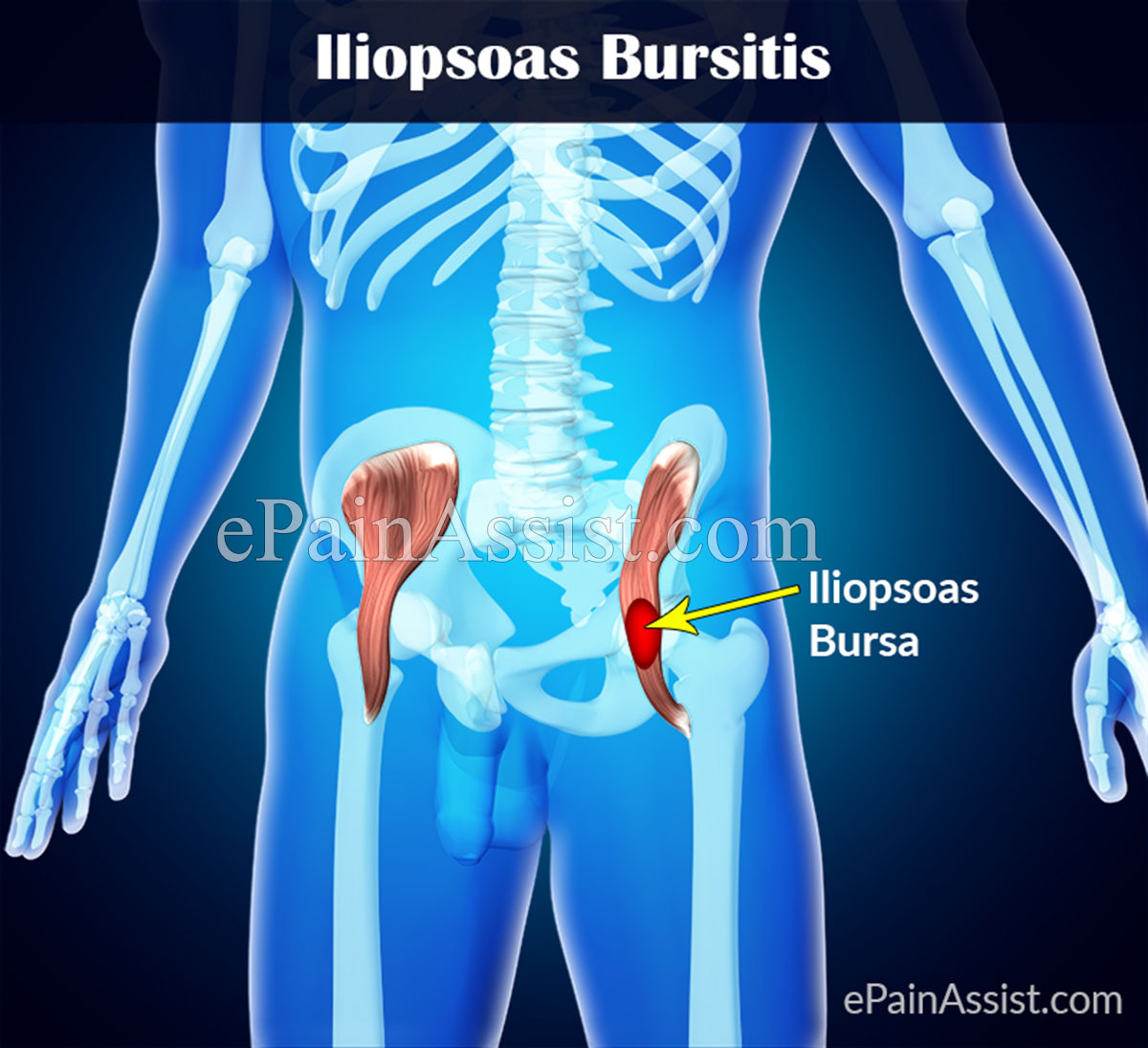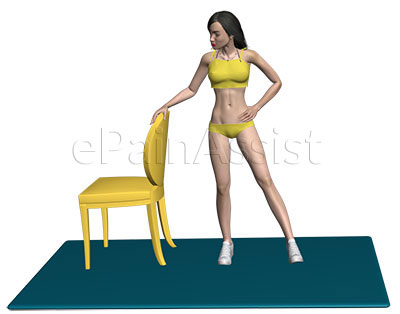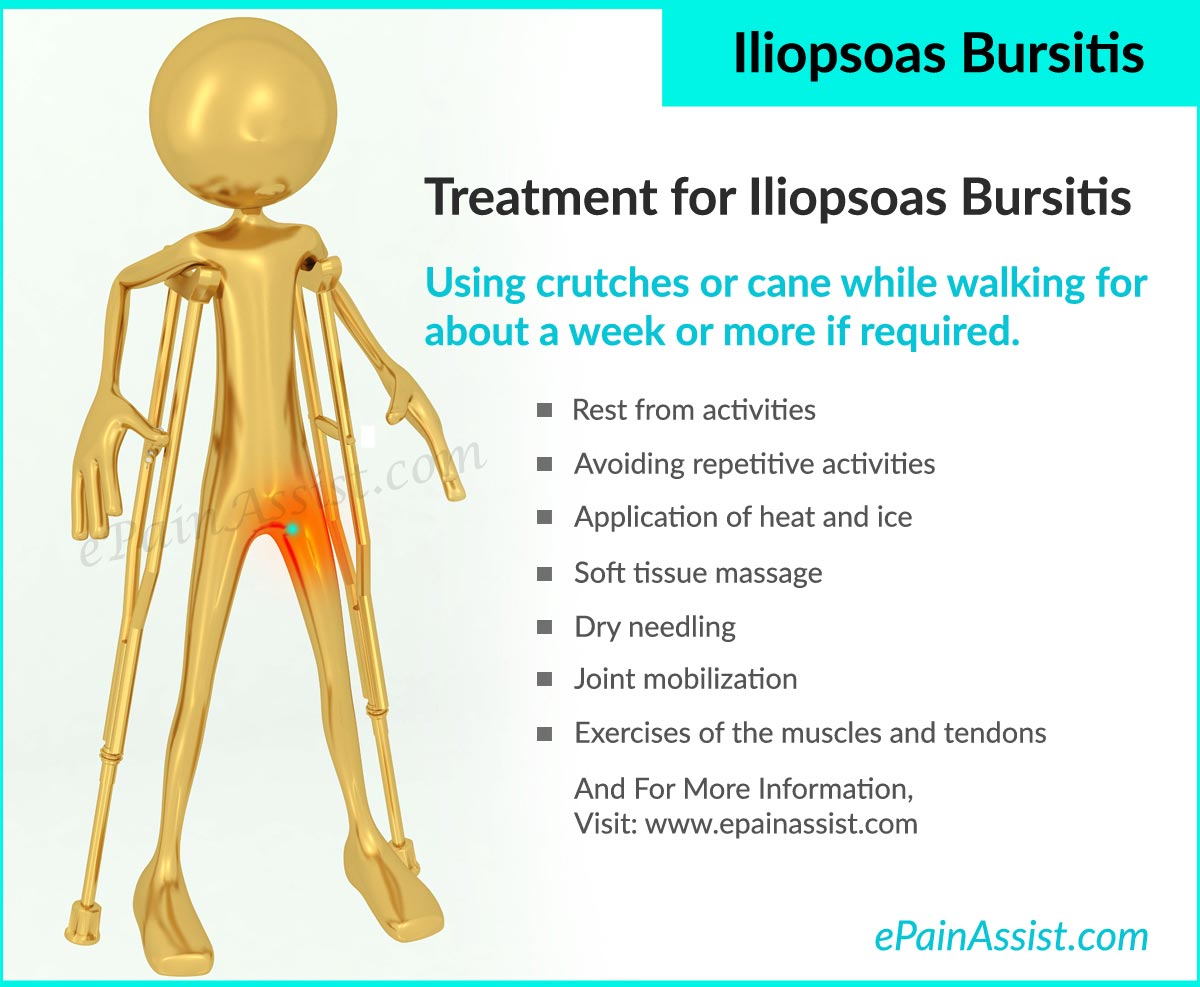This Article Discusses About:
What is Iliopsoas Bursitis or Iliopectineal Bursitis?
Bursitis could be explained as an inflammation of the bursa that is a sac filled with fluid adjacent to the joints that acts like a cushion for the joint.
A bursa is a sac that is filled with lubricating fluid situated between tissues like muscles, tendons, skin and bone that lessens irritation and friction between the tissues. The bursa causes pain in the hip when subjected to continual trauma resulting in swelling and inflammation.[1] This could strongly affect athletes such as runners, footballers, and soccer players who frequently put the entire weight of their body on their hips.

The largest bursa of the body is known as iliopsoas bursa, which is located between the front side of the joint of the hip and the iliopsoas muscle i.e. a hip flexor. Iliopsoas bursa reduces friction between the iliopsoas muscle and thigh bone.[2] When iliopsoas bursa becomes inflamed, the condition is called as iliopsoas bursitis. However, sometimes this condition may also be mistakenly assumed as hip joint arthritis or iliopsoas tendinitis due to the similarity of symptoms. Iliopsoas bursitis often occurs due to trauma and overuse, which involves hip flexion such as weight lifting and squatting resulting in imbalance or tightness of iliopsoas muscle, but this can be treated through strengthening and stretching exercises.[3]
Iliopsoas bursitis is also known as iliopectineal bursitis.
Causes and Risk Factors of Iliopsoas Bursitis or Iliopectineal Bursitis

Iliopsoas bursitis or iliopectineal bursitis is caused due to an overuse injury, which results from repetitive rubbing of the iliopsoas tendon. Iliopsoas bursitis is most common in sports, which involve repetitive activities such as swimming and running.
Other Causes of Iliopsoas Bursitis or Iliopectineal Bursitis May Include:
- Iliopsoas tendonitis.
- Tight hip flexor muscles.
- Osteoarthritis.
- Rheumatoid arthritis.
- Hip problems.
- Recreational injuries such as ballet, soccer, martial arts and jumping hurdles.
- Infection of hip bursa.[4]
Signs and Symptoms of Iliopsoas Bursitis or Iliopectineal Bursitis
- One of the common symptoms of Iliopsoas bursitis or iliopectineal bursitis is that the pain is experienced at the front side of the hip.
- Radiation of pain into the knee.
- Tenderness in the upper quads and at the front side of the hip can also be a symptom of Iliopsoas bursitis or iliopectineal bursitis.
- Radiation of pain into the lower back or buttocks.
- A snapping sensation at the front of the hip.
- Pain on resisted hip flexion.
- Pain on passive hip extension.
- Stiffness and pain after rest or in the mornings.
- Aggravation of pain while performing activities.
Treatment for Iliopsoas Bursitis or Iliopectineal Bursitis
- Rest from activities that aggravate symptoms of Iliopsoas bursitis or iliopectineal bursitis.
- Avoiding repetitive activities.
- Application of ice is an effective treatment to help relieve inflammation and pain associated with Iliopsoas bursitis or iliopectineal bursitis.
- Anti-inflammatory medications such as ibuprofen, aspirin, Celebrex and naproxen may help in reducing inflammation and swelling and relieving pain associated with Iliopsoas bursitis or iliopectineal bursitis.
- Another effective treatment for Iliopsoas bursitis or iliopectineal bursitis is Corticosteroid injections, where the medication is injected into the bursa, which not only helps in reducing the inflammation and pain, but also alleviates the symptoms.
- Using crutches or cane while walking for about a week or more if required.[5]
Physical Therapy
Physical therapy treatment is important in speeding up the recovery period of Iliopsoas bursitis or iliopectineal bursitis. Physical therapy also decreases the likelihood of recurrences in the future.
Physical Therapy for Iliopsoas Bursitis or Iliopectineal Bursitis May Include:[6]
- Application of heat and ice.
- Electrotherapy like TENS and ultrasound.
- Soft tissue massage.
- Stretches.
- Dry needling.
- Joint mobilization.
- Using crutches.
- Correction of abnormal biomechanics such as using orthotics.
- Education.
- Anti-inflammatory advice.
- Exercises of the muscles and tendons surrounding the area to improve strength and flexibility.
- Activity modification and training.
- Appropriate plan for return to activity.
Exercises for Iliopsoas Bursitis or Iliopectineal Bursitis
Hip Flexor Stretch Exercise for Iliopsoas Bursitis or Iliopectineal Bursitis:

This exercise is performed by placing the knee of the affected leg on the floor in such a way that the entire lower leg must lie directly on the floor. Now by bending the other knee lean forward slightly until a pain free stretch is felt in the front side of the thigh. Hold the position for about 30 seconds and release. Perform three times. Hip flexor stretching exercise for Iliopsoas bursitis or iliopectineal bursitis not only helps in stretching the iliopsoas muscle, but also improves stiffness of the joint of the hip.
Straight Leg Raises Exercise for Iliopsoas Bursitis or Iliopectineal Bursitis:

This exercise for Iliopsoas bursitis or iliopectineal bursitis is performed by lying down on the back and straightening out the injured leg. Now place the foot flat of the healthy leg on the floor by bending at the knee. By tightening the thigh muscles gradually lift the injured leg in the upward direction until it reaches the level of the thigh on the opposite side. Hold the position for about one second and release. Repeat 10 times. Repeat the same exercise on the opposite leg. Straight leg raises help in strengthening the quadriceps muscle and iliopsoas present in the thigh.
Sitting Hip Flexion Exercise for Iliopsoas Bursitis or Iliopectineal Bursitis:

This exercise is performed by sitting on a chair or a table. Now by bending the right knee gradually lift the right knee in the upward direction as high as possible until a pain free stretch is felt. Hold the position for about one second and release. Repeat 10 times. Repeat the same exercise on the left side.
Standing Resisted Hip Flexion Exercise for Iliopsoas Bursitis or Iliopectineal Bursitis:

This exercise for Iliopsoas bursitis or iliopectineal bursitis is performed with the help of rubber resistance band. Tie the two ends of the band in order to make a loop. By placing the band around the leg of a table keep the foot into the loop and stand by keeping body away from the band in such a way that the band loops around the front side of the ankle. Now by tightening the muscles of the hip gradually pull the foot in the forward direction. Perform 3 sets of 10. Standing resisted hip flexion also improves the strength of iliopsoas.
Gluteal Stretch Exercise for Iliopsoas Bursitis or Iliopectineal Bursitis:

This exercise is performed by lying down on the back. With the help of hands, bring the knee towards the opposite shoulder until a mild to moderate pain-free stretch is felt along the buttocks or at the front side of the hip. Hold the position for about 15 seconds and release. Repeat four times ensuring there is no exacerbation of pain.
Tests to Diagnose Iliopsoas Bursitis or Iliopectineal Bursitis
Generally a complete subjective, objective, and physical examination is performed to diagnose iliopsoas bursitis.
Other tests that help in ruling out other problems may include:[7]
- Ultrasound.
- X-ray.
- MRI.
- Bone scan.
- https://www.ncbi.nlm.nih.gov/books/NBK513340/
- https://www.ncbi.nlm.nih.gov/books/NBK535418/
- https://www.science.gov/topicpages/e/enlarged+iliopsoas+bursa
- https://www.mayoclinic.org/diseases-conditions/bursitis/symptoms-causes/syc-20353242
- https://www.physio-pedia.com/Iliopsoas_Bursitis
- http://southshoreorthopedics.com/wp-content/uploads/2016/12/Hip_bursitis-tendinitis.pdf
- https://www.ncbi.nlm.nih.gov/pmc/articles/PMC3177464/
Also Read:
- Hip Bursitis or Trochanteric Bursitis: Causes, Symptoms, Treatment, Exercises
- What is Hip Dislocation?|Types, Treatment, Exercises for Hip Dislocation
- Hip Flexor Strain: Types, Causes, Symptoms, Treatment. Exercise, Recovery
- Hip Sprain: Causes, Symptoms, Treatment, Exercises
- Hip Joint Bursitis & Tendinitis- Causes, Signs, Symptoms, Diagnosis, Treatment

